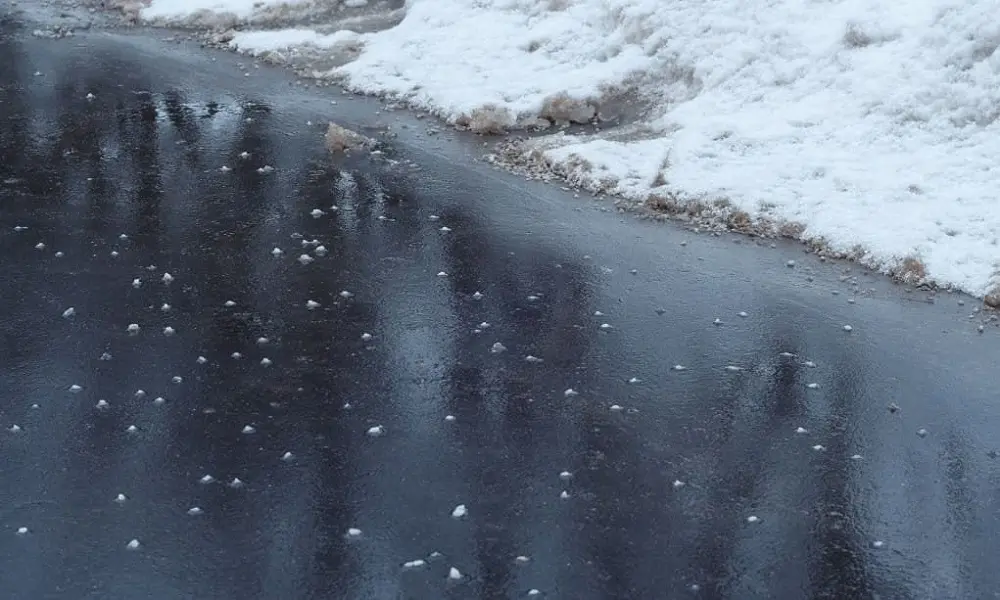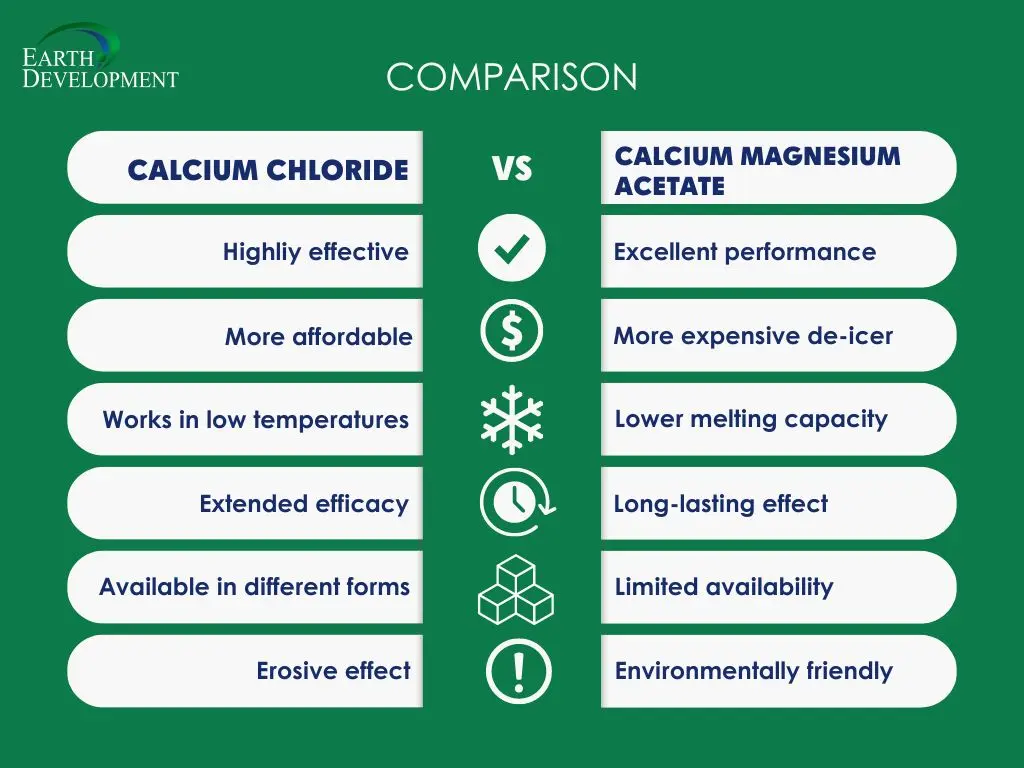For any business that has had to deal with snow removal and ice management, the words “Calcium Chloride” and “Calcium Magnesium Acetate” might mean more to you than to most people. These are two extremely common deicing agents used to reduce ice formation and snow build-up.
The two ice melting products are extremely effective, but they have different qualities. The fact that these two products work at different speeds under different conditions is just one of the reasons why the advice of snow removal experts is so important. After all, getting the wrong one means wasting time and money.
So what are the differences between these two popular deicing agents?
Calcium Magnesium Acetate (CMA)

Calcium magnesium acetate (CMA) is a deicing and anti-icing agent that is less corrosive and harmful to the environment than sodium chloride (rock salt). CMA is produced by reacting dolomitic limestone with acetic acid. It works by lowering the freezing point of water, which helps melt ice on roads, bridges, sidewalks, and other paved surfaces. Its biodegradability and low toxicity make it a good option to protect the environment while still effectively melting snow and ice.
Calcium Magnesium Acetate is a popular alternative to traditional rock salt and is typically used on ground that may be vulnerable to corrosion. Let’s take a look at its pros and cons.
Pros of Calcium Magnesium Acetate
- Effectiveness: Calcium Chloride Acetate (CMA) is a highly effective de-icing agent, capable of melting ice and snow at low temperatures.
- Environmentally friendly: CMA is considered to be more environmentally friendly compared to other de-icing agents. It has a lower environmental impact and is less harmful to aquatic life and vegetation.
- Less corrosive: Calcium Magnesium Acetate is as corrosive as normal tap water, making it ideal for asphalt and concrete surfaces that are vulnerable to corrosion.
- Safe for pets and wildlife: CMA is generally considered safe for pets and wildlife when used as directed, making it a preferred choice in areas where animal exposure is a concern.
- Longer-lasting: CMA has a longer residual effect compared to other de-icing agents, reducing the need for frequent reapplication and potentially saving on costs.
Cons of Calcium Magnesium Acetate
- Limited availability: Calcium Chloride Acetate (CMA) may not be as readily available as other de-icing agents, which can make it more difficult to source.
- Higher cost: CMA can be more expensive compared to other de-icing agents, which may increase the overall cost of using it for ice and snow removal.
- Lower melting capacity: CMA may have a lower melting capacity compared to other de-icing agents, which means it may take longer to melt ice and snow.
- Potential for residue: CMA can leave behind a residue after melting ice, which may require additional cleaning or maintenance to remove.
Calcium Chloride
Calcium Chloride is one of the other top deicing agents used by professional snow and ice removal experts, and it offers a few unique benefits.
Not only that, but this substance works fast. Really fast. Calcium Chloride can melt twice as much ice and snow as rock salt. It also helps minimize dust on the roads and doesn’t leave behind the kind of residue that you might expect from rock salt.
Pros of Calcium Chloride
- Fast-acting: Calcium Chloride works quickly to melt ice and snow, making it ideal for use in time-sensitive situations.
- Long-lasting: It has a long-lasting effect, preventing ice from reforming for an extended period of time.
- Works in extreme temperatures: Calcium Chloride is effective in extremely cold temperatures, even as low as -25°F (-32°C).
- Penetrates ice and snow: It has the ability to penetrate through thick ice and snow layers, helping to break them up and facilitate removal.
- Versatile: It can be used on various surfaces, including concrete, asphalt, and metal.
- Cost-effective: Calcium Chloride is relatively affordable compared to other de-icing agents, making it a cost-effective option for winter maintenance.
- Available in different forms: It is available in different forms, including pellets, flakes, and liquid, allowing for easy application and versatility in different situations.
Cons of Calcium Chloride
- Corrosive: Calcium Chloride is highly corrosive and can damage metal surfaces, including vehicles, infrastructure, and equipment.
- Cost: This substance is slightly more expensive than CMA and rock salt.
- Limited effectiveness in extremely low temperatures: While Calcium Chloride is effective in cold temperatures, it may not work as well in extremely low temperatures, such as below -25°F (-32°C).
- Potential for over-application: Over-application of Calcium Chloride can lead to excessive melting, which can result in water pooling and refreezing, creating slippery conditions.
- Environmental impact: Calcium Chloride runoff can contaminate water bodies and harm aquatic life. It can also damage vegetation and soil.
- Harmful to pets: Calcium Chloride can be harmful to pets if ingested or if it comes into contact with their paws. It can cause irritation, burns, and gastrointestinal issues.
- Can stain surfaces: Calcium Chloride can leave behind white residue or stains on surfaces, including concrete, carpets, and clothing.
- Storage and handling precautions: Calcium Chloride requires proper storage and handling to prevent spills, leaks, and accidental ingestion.
What Do These Two Have in Common?
Both Calcium Chloride and Calcium Magnesium Acetate are effective deicing agents that are less caustic than Sodium Chloride (rock salt). That means they’re ideal for concrete and asphalt, causing less damage and corrosion to these outdoor surfaces.
They are pet-friendly, plant-friendly, and they’re ideal for use as a pre-treatment to prevent ice from bonding to pavements. Using these agents makes it easier to clear snow away from the ground, which means snow removal is quicker and simpler.
What’s more, they can both be mixed with regular rock salt or even sand. This reduces costs when combined with rock salt, and increases friction on the ground when combined with sand. All in all, they are fantastic options for any company with outdoor spaces and entryways that are compromised during the winter months.
Calcium Chloride vs Calcium Magnesium Acetate: Compare and Contrast
Understanding the difference between Calcium Chloride and Calcium Magnesium Acetate is crucial for effective de-icing strategies.
1. Application: Which One Is Easier to Use?
When it comes to ease of application, calcium chloride has some advantages over calcium magnesium acetate (CMA). Calcium chloride can be applied conveniently as flakes or pellets, which are easy to spread with a hand spreader or broadcast spreader. It is also available as a liquid solution which can be sprayed or poured.
CMA is primarily used as a solid particle that needs to be manually spread. The small pellet size of CMA can make consistent coverage challenging compared to the flakes of calcium chloride. Additionally, calcium chloride pellets tend to stick to ice better than CMA pellets. However, CMA is less prone to bouncing and scatter during application.
Overall, the flake or liquid forms of calcium chloride provide more convenient, consistent coverage and adhesion to ice compared to the pellet application of CMA. So for ease of application, calcium chloride is generally the better option.
Easier to Use: Calcium Chloride
2. Cost: Which One Is More Cost-Effective?
- Calcium Chloride and Calcium Magnesium Acetate (CMA) vary in terms of cost. Generally, Calcium Chloride is considered to be more cost-effective compared to Calcium Magnesium Acetate.
- Calcium Chloride is widely available and has a lower price point, making it a more budget-friendly option for de-icing.
- Calcium Magnesium Acetate tends to be more expensive due to its manufacturing process and limited availability.
More affordable: Calcium Chloride
3. Effectiveness: Which De-Icer Works the Best?
Calcium Chloride is known for its ability to melt ice and snow even at very low temperatures. It is a popular choice for extremely cold conditions where other de-icers may not be as effective.
On the other hand, Calcium Magnesium Acetate (CMA) is also effective in lower temperatures but may have reduced effectiveness in extremely cold conditions. It’s often preferred for milder winter conditions or when environmental impact is a concern.
More effective: Calcium Chloride
4. Safety: Calcium Chloride vs Calcium Magnesium Acetate

Is Calcium Chloride or Calcium Magnesium Acetate Safer for Concrete?
- CMA does not contain chlorides, so it is much less likely to cause corrosion or spalling of concrete. Research shows minimal concrete damage from CMA even after many freeze/thaw cycles and applications.
- Calcium chloride ice melt works quickly but can damage concrete over time. The chlorides penetrate porous concrete and cause scaling when moisture freezes and thaws.
Which One Is Safer Landscaping?
- Calcium Chloride, when used in high concentrations or with excessive runoff, can potentially harm vegetation and aquatic life due to its increased salinity.
- Calcium Magnesium Acetate has a lower environmental impact and is often preferred in areas where landscape and plant safety are a concern.
Calcium Chloride vs Calcium Magnesium Acetate: Which One Doesn’t Damage Your Vehicle?
When it comes to vehicle safety, calcium magnesium acetate (CMA) is less corrosive than calcium chloride.
- While calcium chloride is less damaging than salt, it can still cause corrosion issues on cars, trucks, and other vehicles over time. The chloride ions are the main culprit behind increased rust and oxidation.
- Calcium chloride solutions may also stain finishes or cling to vehicles and leave a white residue when dry.
- CMA’s lack of chlorides makes it the safer choice for long-term vehicle exposure.
- Calcium Magnesium Acetate does not contain chlorides, so it poses minimal risk of corrosion to metal surfaces. However, CMA’s acetates can potentially damage paint or other coatings through direct contact, especially on older finishes.
Are Calcium Chloride and Calcium Magnesium Acetate Pet-Friendly?
- Calcium Chloride can be irritating to pets’ paws if they come into direct contact with it.
- Calcium Magnesium Acetate is generally considered to be “pet-friendly”, as it is less likely to cause irritation.
More safe: Calcium Magnesium Acetate

Which One Should You Choose for Your Commercial Property?
It depends on your situation! If you need something affordable that works at moderately cold temperatures, CMA is perfect for you.
However, for more severe winter weather, Calcium Chloride may be the right option.
And don’t forget…you can always combine substances, and even introduce regular rock salt and sand to the mix!
Why Not Leave It to the Experts?
At Earth Development, we know precisely what deicing agents are best for your property. So why not leave it to the experts? Give our team a call and we’ll arrange a consultation and a free quote, and our local snow removal experts will come up with an ice management plan to see you through the winter!
With over a decade of experience in commercial snow removal, the team at Earth Development can assess your property and customize an ice management plan using the most effective, eco-friendly deicers. We’ll create walkways that are safe for pets and pedestrians without damaging your concrete.
Contact us today to get proactive about snow removal this winter season. Our experts are ready to see you through the storms ahead.
